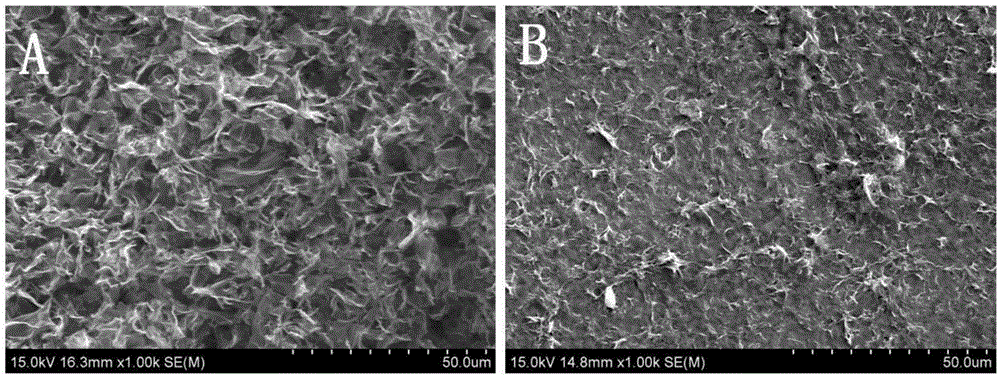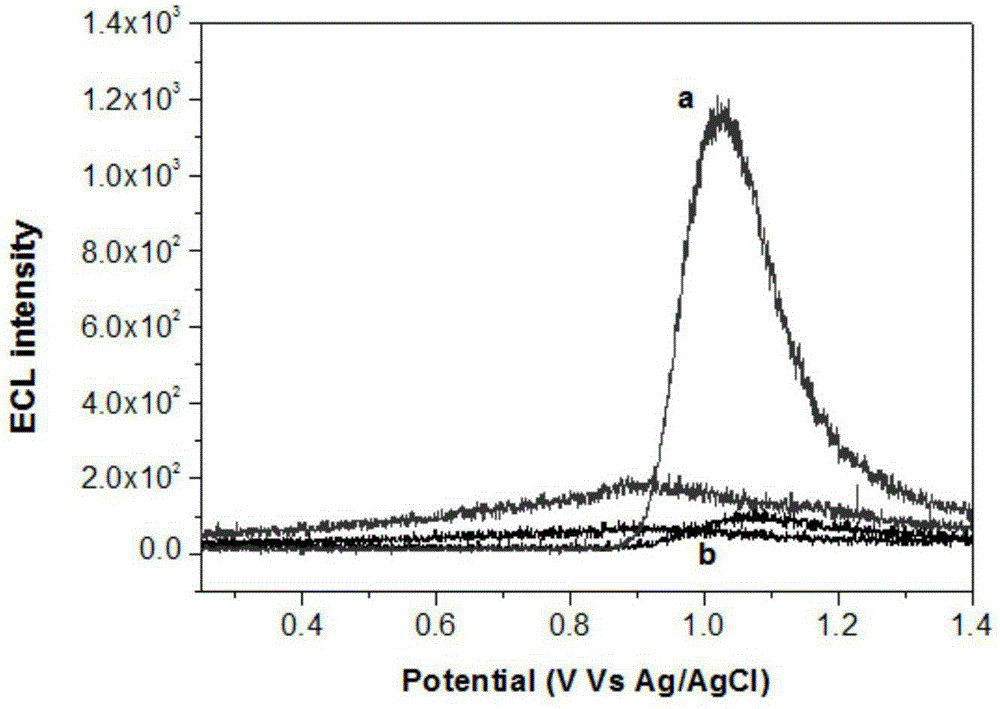Method for constructing terpyridyl ruthenium electrochemiluminescence sensor from graphene porous material
A ruthenium terpyridine electrochemical and porous material technology, applied in the direction of material electrochemical variables, can solve the problems of increasing electrode surface resistance, loss of electrode surface pore structure, affecting the performance of electrochemiluminescence sensors, etc., to achieve good porous structure, good Conductivity, the effect of preventing the reduction of the active area of the electrode
- Summary
- Abstract
- Description
- Claims
- Application Information
AI Technical Summary
Problems solved by technology
Method used
Image
Examples
Embodiment 1
[0026] Measure 6mL of 2.5wt% polyvinyl alcohol solution into 35mg of graphene oxide contained in a beaker, and obtain a uniform dispersion after ultrasonic dispersion for 40min. The obtained graphene oxide dispersion was then frozen by placing the beaker in a bath filled with liquid nitrogen. After it is completely frozen, put the obtained solution into a freeze dryer whose freezing temperature has reached -60°C, turn on the vacuum mode, and operate the vacuum freeze dryer in vacuum freezing mode for 48 hours until the water in the sample is completely sublimated. A graphene oxide porous composite is obtained. Subsequently, the prepared graphene oxide porous composite was calcined in a nitrogen atmosphere at 750 °C for 2 h at a heating rate of 5 °C / min. After the calcination is completed, the sample is taken out to obtain a graphene porous material. Take PGR and ultrasonically disperse it into 1wt% Nafion solution to prepare 1.25mgmL -1 PGR. Take a suspension of 5 μL PGR a...
Embodiment 2
[0028] Measure 6mL of 2.5wt% polyvinyl alcohol solution into 35mg of graphene oxide contained in a beaker, and obtain a uniform dispersion after ultrasonic dispersion for 40min. The obtained graphene oxide dispersion was then frozen by placing the beaker in a bath filled with liquid nitrogen. After it is completely frozen, put the resulting solution into a freeze dryer whose freezing temperature has reached -60°C, turn on the vacuum mode, and operate the vacuum freeze dryer in vacuum freezing mode for 40 hours until the water in the sample is completely sublimated. The graphene oxide porous composite (PGR) is obtained. Subsequently, the prepared graphene oxide porous composite was calcined in a nitrogen atmosphere at 750° C. for 3.5 h at a heating rate of 5° C. / min. After the calcination, the sample is taken out to obtain a porous block reduced to graphene. Take a certain amount of PGR and ultrasonically disperse it into 1wt% Nafion solution to prepare 5mgmL -1 PGR.
[002...
Embodiment 3
[0032] Measure 5 mL of 2.5 wt% PVA solution and add it to 35 mg of graphene oxide contained in a beaker, and obtain a uniform dispersion after ultrasonic dispersion for 40 min. The obtained graphene oxide dispersion was then frozen by placing the beaker in a bath filled with liquid nitrogen. After it is completely frozen, put the resulting solution into a freeze dryer whose freezing temperature has reached -60°C, turn on the vacuum mode, and operate the vacuum freeze dryer in vacuum freezing mode for 55 hours until the water in the sample is completely sublimated. The graphene oxide porous composite (PGR) is obtained. Subsequently, the prepared graphene oxide porous composite was calcined in a nitrogen atmosphere at 800° C. for 1.5 h at a heating rate of 2° C. / min. After the calcination, the sample is taken out to obtain a porous block reduced to graphene. Take a certain amount of PGR and ultrasonically disperse it into 1wt% Nafion solution to prepare 2.5mgmL -1 PGR. Take ...
PUM
 Login to View More
Login to View More Abstract
Description
Claims
Application Information
 Login to View More
Login to View More - R&D
- Intellectual Property
- Life Sciences
- Materials
- Tech Scout
- Unparalleled Data Quality
- Higher Quality Content
- 60% Fewer Hallucinations
Browse by: Latest US Patents, China's latest patents, Technical Efficacy Thesaurus, Application Domain, Technology Topic, Popular Technical Reports.
© 2025 PatSnap. All rights reserved.Legal|Privacy policy|Modern Slavery Act Transparency Statement|Sitemap|About US| Contact US: help@patsnap.com


